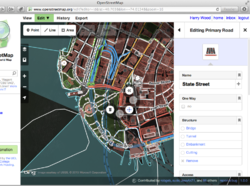iD
| iD | ||||||||||||||||||||||||||||||||||||||||||||||||||||||||||||||
|---|---|---|---|---|---|---|---|---|---|---|---|---|---|---|---|---|---|---|---|---|---|---|---|---|---|---|---|---|---|---|---|---|---|---|---|---|---|---|---|---|---|---|---|---|---|---|---|---|---|---|---|---|---|---|---|---|---|---|---|---|---|---|
| Author: | openstreetmap/iD/graphs/contributors GitHub | |||||||||||||||||||||||||||||||||||||||||||||||||||||||||||||
| License: | ISC License (free of charge) | |||||||||||||||||||||||||||||||||||||||||||||||||||||||||||||
| Platform: | Web | |||||||||||||||||||||||||||||||||||||||||||||||||||||||||||||
| Status: | Active | |||||||||||||||||||||||||||||||||||||||||||||||||||||||||||||
| Version: | 2.37.3 iD releases (2025-10-31)
6.13.2 iD tag.schema rel. (2025-10-30) | |||||||||||||||||||||||||||||||||||||||||||||||||||||||||||||
| Languages: | ||||||||||||||||||||||||||||||||||||||||||||||||||||||||||||||
| Website: | ideditor.com | |||||||||||||||||||||||||||||||||||||||||||||||||||||||||||||
| Source code: | openstreetmap/iD GitHub | |||||||||||||||||||||||||||||||||||||||||||||||||||||||||||||
| Programming language: | JavaScript | |||||||||||||||||||||||||||||||||||||||||||||||||||||||||||||
|
The easy-to-use OpenStreetMap editor in JavaScript. |
||||||||||||||||||||||||||||||||||||||||||||||||||||||||||||||
| ||||||||||||||||||||||||||||||||||||||||||||||||||||||||||||||
- For other uses, see Id (disambiguation).
iD is an in-browser app used to edit the OpenStreetMap, and is the default editor at the openstreetmap.org homepage.
The app aims to be simple and friendly. It is programmed in JavaScript so as to be usable without plugins.
It has been the most popular editor since 2013. In 2024 it was used by 204,810 mappers (78% of all mappers).[1]
How to use it
You can use iD with your web browser on the OpenStreetMap.org home page. Simply zoom in on the area you are interested in and click the Edit button!
- Note for advanced users: In your user preferences you can set the "Edit" button to launch different editors. If you do, you still can find "iD" in the "Edit ▼" menu drop-down. By default, though, new users would click simply "Edit".
There is an interactive walkthrough inside the editor, which you see when you first access it. This is always accessible later via the [?] icon at the bottom of the icon stack on the right-hand side (keyboard shortcut is H).
A more detailed tutorial for iD can be found at the LearnOSM web site.
A list of keyboard shortcuts is here.
You can browse a collection of discussions related to iD on community.osm.org. If your question has not been asked already, just add it. Very old questions and answers can be found by searching on help.osm.org, which is currently archived, via DuckDuckGo.
There are many other channels where you can get help.
Community Chats
Regular online community meetups are organized to chat about the iD editor and the ecosystem around it.
Technical
iD uses d3js as a rendering layer and has a fast, modular core that manages OSM data. The primary mode of rendering is via SVG, though other renderers will be considered in the future.
- Project introduction
- Code on GitHub
- iD readme (how to contribute, translate, install on a server, etc.)
- iD GitHub wiki home page (all pages; technical and project information)
- versions
- Bug reports
- Uses the Name Suggestion Index for brand presets
- Uses the Editor Layer Index to manage the background layers
- Uses the OSM Community Index to suggest community contacts
- Uses the Data items to fetch multilingual tag descriptions and images from the OSM Wikibase since iD v2.13 (2019-Jan-23)[2][3][4]
Contributions are very warmly welcomed. Currently User:tyr, User:bhousel and others are contributing.
Test a prerelease version of iD
- Stable mirror of
releasebranch: https://ideditor-release.netlify.app (http://preview.ideditor.com/release) - Development version (development mirror) of
masterbranch + latest translations: https://ideditor.netlify.app (http://preview.ideditor.com/master)
Localisation / translation
iD uses transifex for translations https://www.transifex.com/openstreetmap/id-editor more information on GitHub.
Project history
Its development began in summer 2012 and it is available for use on the openstreetmap.org homepage since May 2013. In August 2013 it replaced Potlatch 2 as the default editor[5].
Alpha and beta
On July 13, 2012 Richard Fairhurst published a blog post where he announced he was working on a new JavaScript based OpenStreetMap editor. By the time he was already famous within the OSM community for his web editors Potlatch and Potlatch2 written in Flash, and as it was clear that there was no future for Flash based applications, iD was the consequential next step.
Some months later on September 20, Mapbox announced they had been granted 575,000 USD from Knight Foundation to improve the core infrastructure of OpenStreetMap, and that they were planning to use it for the development of the iD editor. The first alpha version was released on December 21, 2012 and the beta version on April 2, 2013. This initial development was primarily done at Mapbox by Tom MacWright, John Firebaugh, Saman Bemel-Benrud and Ansis Brammanis.
Version 1 onward
On May 9, 2013 version 1.0 was released.
Bryan Housel maintained the project until 2020. Quincy Morgan was the appointed iD maintainer until Apr. 26th, 2021. Milos Brzakovic was the interim maintainer from then until the appointment of Martin Raifer (known also as tyr_asd or tyrasd) in November 2021.[6]
Validation
Since software version 2.14 (Feb. 2019) there is an implemented integrated Issue manager and advanced validation system available.
Controversial decisions
- Main article: iD/Controversial Decisions
Some decisions by the maintainers were appearing controversial or were lacking support by the community. In June 2020, the OSMF board asked for comments on potential approaches to resolving controversies.[7][8][9]
News
See also: entries of the Mapbox OSM Development blogs.[10]
- In the works: iD 1.1 ("iD 1.1 is nearing release. I've just tagged 1.1.0rc1") (2013-07-31)
- Tuning OpenStreetMap Editing: iD Editor 1.1 (2013-06-06)
- Previewing User Interface Improvements in iD Version 1.1 (2013-05-30)
- iD launch on the osm.org (2013-05-07)
- iD reaches Beta 1 (2013-04-02)
- iD alpha3 (2013-03-11)
- Design iD (2013-01-11)
- iD Updates (2012-11-14)
- First steps with iD editor (2012-10-25)
- It all starts with an editor: the blog edit. (2012-10-14)
- Building a friendly editor for OpenStreetMap in JavaScript. The "initial post" on Open Geo Data (2012-07-13)
Press coverage
Further reading
- Raifer, Martin. “10 Years iD Editor – The Road Ahead”. State of the Map 2022. Florence: OpenStreetMap Foundation.
See also
- Comparison of editors
- JOSM - OpenStreetMap desktop editor written in Java
- Rapid - A fork of iD sponsored by Meta
External links
- iD (software) on Wikipedia
- Beginning of iD - description of how iD started
- iD version playground (hosted copies of versions 1.0 through 2.21)
References
- ↑ Editor usage stats#by number of users (distinct uids)
- ↑ nyurik: Pull request #5647 Fetch multilingual tag descriptions and images from the OSM Wikibase. GitHub, 2018-12-22 Archived article
- ↑ bhousel: Commit bc72c38 Merge pull request #5647 from nyurik/osm_wikibase. GitHub, 2018-12-26 Archived article
- ↑ quincylvania: Release iD v2.13. GitHub, 2019-01-23 Archived article
- ↑ https://blog.openstreetmap.org/2013/08/23/id-in-browser-editor-now-default-on-openstreetmap/ and https://github.com/openstreetmap/openstreetmap-website/pull/453
- ↑ https://blog.openstreetmap.org/2021/11/05/self-introduction-of-the-new-id-developer
- ↑ https://lists.openstreetmap.org/pipermail/talk/2020-June/084859.html
- ↑ https://lists.openstreetmap.org/pipermail/osmf-talk/2020-June/006865.html
- ↑ https://blog.openstreetmap.org/2020/06/08/toward-resolution-of-controversies-related-to-id
- ↑ “MapBox OSM Development”. Mapbox. 19 July 2013. Archived from the original on 26 June 2018.

